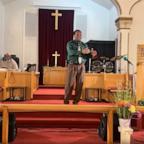Twister offers eye into storms
— -- A tornado that swept across a remote corner of Wyoming last week might give scientists the data they need to save lives.
The furious storm, which hit just east of the frontier town of Chugwater on June 5, was the most documented tornado in history, says Josh Wurman, president of the Center for Severe Weather Research in Colorado.
Wurman, one of the principal investigators with VORTEX2 (Verification of the Origins of Rotation in Tornadoes Experiment 2), the largest-ever tornado study, says the Chugwater twister will be studied for years as scientists seek to learn what causes the killer storms to form.
The study's field work began in May and ends Saturday. About 1,000 tornadoes form in the USA each year, killing about 60 people, according to the federal Storm Prediction Center in Norman, Okla. The original VORTEX study was conducted in the mid-1990s and helped inspire the film Twister.
"We watched that tornado probably 45 minutes or even longer, and we were able to observe its entire life cycle," Wurman said of the Wyoming storm.
Never before has so much equipment been in place to document conditions in and around a tornado from its genesis to its death, Wurman says. It swooped over 12 data-collecting "tornado pods," left on Highway 85 before the storm, as well as other equipment, he says.
Researchers are trying to learn more about how tornadoes form in order to find better ways of predicting when and where they will strike, says Don Burgess, a research scientist with the University of Oklahoma who is part of the project.
For instance, he says, scientists might find previously unknown "signatures" in radar images which could alert forecasters to tornado threats and prompt warnings. A long-range goal is the ability to warn people of a tornado 30 minutes — or even an hour — before a tornado hits, he says.
Mike Bettes of The Weather Channel says he was stunned as he shot video of the tornado and was able to peer inside its funnel.
"It started to tilt and became more horizontal," Bettes says. "The top of the tornado just opened up and looked right at us."



